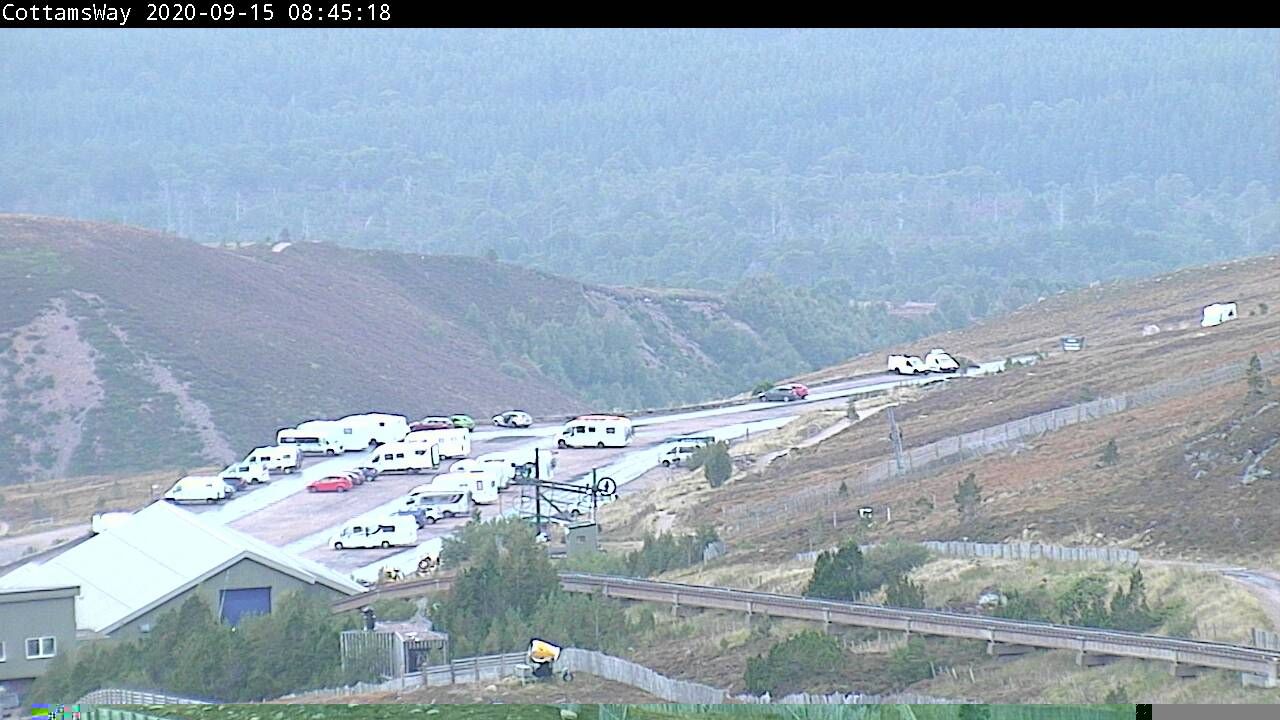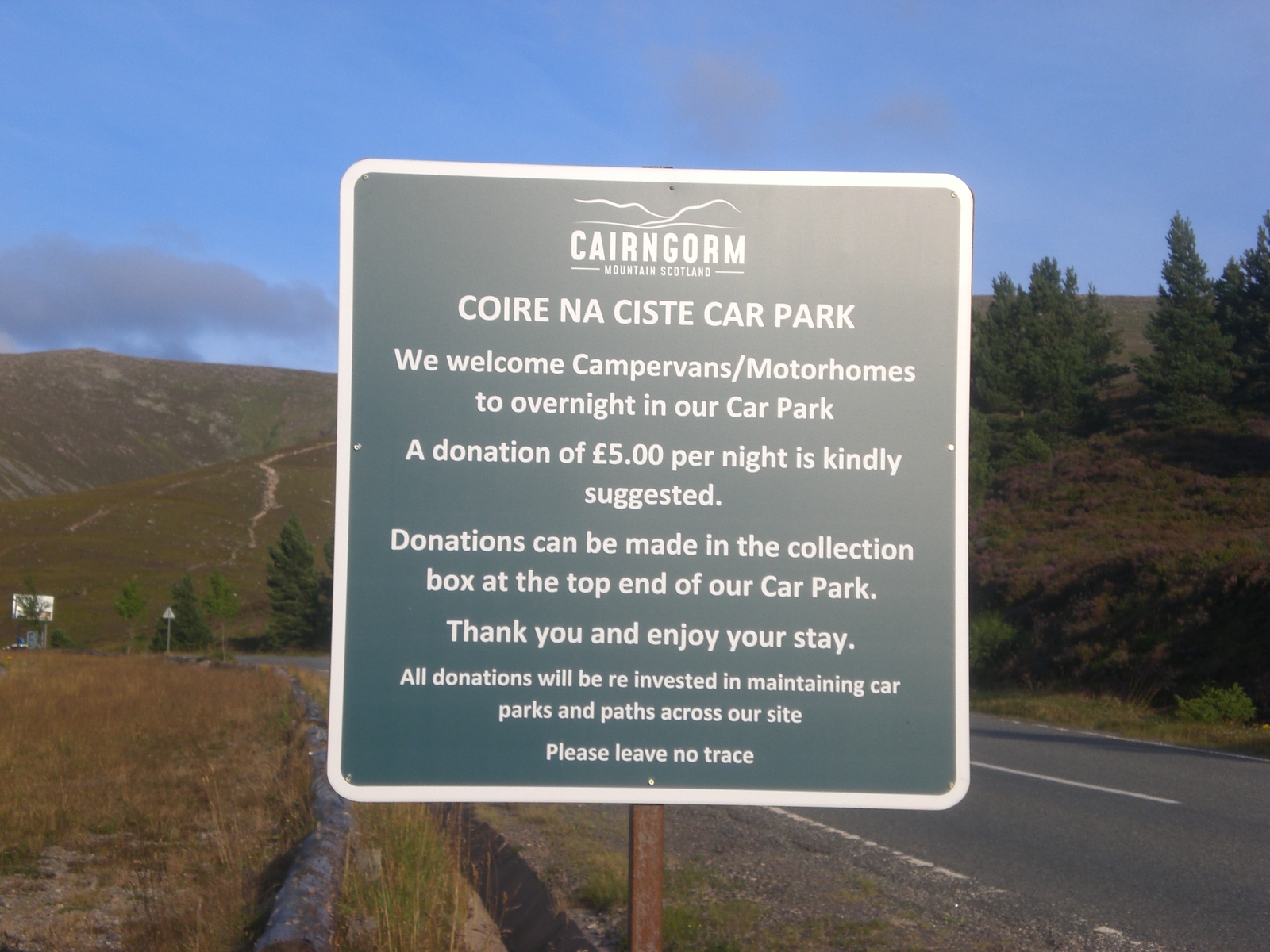
Highlands and Islands Enterprise’s consultation on its draft vision for a masterplan at Cairn Gorm (see here) closed on Monday. The next day, at 8.45 a.m on a wet Tuesday morning in mid-September, how many campervans could be seen in the Coire Cas car park? The numbers were probably higher than normal as the more popular Coire na Ciste car park had been closed to allow helicopter operations.
The business opportunities are obvious. The costs of installing electric hookups and re-opening the toilets in Coire na Ciste could repay the investment in a season, a far better investment than repairing the funicular which has never paid for itself. With this number of campervans, there is clearly sufficient baseline demand to keep the cafe – and the bar – open in the evenings, which in return could provide a service to walkers returning from the hill. A virtuous circle. Yet instead of articulating a vision for basic visitor infrastructure at Cairn Gorm, the masterplan consultation confined itself to asking whether provision could be made for campervans, while leaving the Coire na Ciste car park in its entirety out of the masterplanning area.
There is also, however, a wider opportunity about the management of visitors in Glen More as a whole. The Cairn Gorm car parks, whether you love them or hate them, could play a key role in relieving pressures on the glen below.
| Tues | Wed | Thurs | Fri | Sat | Sun | Monday | Totals | |||
| 14th | 15th | 16th | 17th | 18th | 19th | 20th | ||||
| Loch Morlich Side | 17 | 19 | 23 | 34 | 34 | 18 | 14 | 159 | ||
| Allt Ban Carpark | 0 | 1 | 1 | 1 | 1 | 1 | 0 | 5 | ||
| Hayfield | 0 | 0 | 3 | 6 | 6 | 5 | 2 | 22 | ||
| Allt Mor Carpark | 4 | 4 | 5 | 4 | 6 | 5 | 5 | 33 | ||
| Sugarbowl | 6 | 1 | 2 | 5 | 5 | 2 | 0 | 21 | ||
| Ciste Carpark | 11 | 11 | 12 | 34 | 35 | 20 | 10 | 133 | ||
| Cas Carpark | 0 | 4 | 1 | 6 | 8 | 3 | 1 | 23 | ||
| Totals | 38 | 40 | 47 | 90 | 95 | 54 | 32 | 396 | ||
| Tues | Wed | Thurs | Fri | Sat | Sun | Mon | Totals | |||
| 21st | 22nd | 23rd | 24th | 25th | 26th | 27th | ||||
| Loch Morlich Side | 11 | 11 | 14 | 16 | 16 | 14 | 9 | 91 | ||
| Allt Ban Carpark | 1 | 0 | 1 | 2 | 2 | 1 | 0 | 7 | ||
| Hayfield | 4 | 0 | 4 | 2 | 0 | 2 | 0 | 12 | ||
| Allt Mor Carpark | 4 | 4 | 5 | 5 | 0 | 0 | 1 | 19 | ||
| Sugarbowl | 0 | 0 | 0 | 0 | 2 | 0 | 0 | 2 | ||
| Ciste Carpark | 13 | 11 | 13 | 16 | 16 | 11 | 7 | 87 | ||
| Cas Carpark | 2 | 5 | 6 | 1 | 2 | 2 | 1 | 19 | ||
| Totals | 35 | 31 | 43 | 42 | 38 | 30 | 18 | 237 | ||
Data from Save the Ciste campervan survey conducted in August. A similar survey was taken the year previously.
The photo and the data suggests that the number of campervans staying in Coire Cas has significantly increased since August, possibly as a result of Forest and Land Scotland restricting overnight parking in the glen below.
Aside from parking, Glenmore campsite (currently and unjustifiably closed) has, in recent years, become increasingly used by campervans, removing spaces for campers. Providing facilities for campervans up the hill would help create more space for tents from Spring to Autumn. While at present the Glenmore campsite is a far more pleasant place to stop off, if the car parks were landscaped – the ugly expanses broken up with native trees – and facilities provided, they could become very attractive, with great view out over Glen More. £15 a night for toilet, shower and hook-up – Glenmore campsite charged a mininum of £22.50 mid-season without hookups when last open – would bring in significant income to Cairn Gorm. Unfortunately, no consideration was given to such ideas in HIE’s draft masterplan for Cairn Gorm. A vision without any vision or enterprise.

Until that changes, the current incoherent approach stupidities will continue. HIE’s Planning Application for car park barriers (see here) earlier this summer was submitted on the basis that charges would only be levied during the day, not at night. That is probably the opposite of what needs to happen. There is an argument that parking should be free in the day – to encourage people to use the car parks and not the roadside verges – but that charges could levied overnight in return for facilities being kept open for use. Instead, following its attempt to re-introduce of charges in Coire Cas (see here) HIE is now also trying to charge for nothing at Coire na Ciste. It has still to explain where all the charges levied by Natural Retreats went (see here) It certainly wasn’t spent on the car parks.
Electric hookups are not necessary and impose an additional cost on small and/or self sufficient outfits which don’t have or don’t require them. Thanks to some badly structured legislation intended to protect HMO tenants, if a camping pitch has an electric hook up it must be charged as such whether you plug in or not. Although many commercial sites quietly ignore this the two big clubs understandably feel they would be targeted for fines if they didn’t implement it and sites or stops run by public bodies would inevitably take the same approach.
I didnt know about hmo implications but a certain few will want ehu in summer and more in winter.
I would make the point of banning generators though as we experienced this at the cas carpark this year. Great setting, great view but someone decided the thump of a generator was needed.
So a management plan would be welcome to compliment the location and needs.
The electricity supply regulations is why if you go to a C&CC or CMC site (or some others) and there is only a serviced pitch available, you will be charged for electricity whether you want it or not. There are ways round this with metered or card hookups but the fundamental problem is that the cost of reselling electricity cannot by law include a charge for the reseller’s infrastructure. This makes sense in the HMO situation but should never have applied to touring campsites where the users have the option of not using the electricity or going elsewhere. Only the campsite industry bodies can solve this but I suspect the current status quo suits them quite well in their general move upmarket.
While I agree with a generator ban there needs to be an exception in any rules for those who use them for essential medical reasons although it should still be restricted to properly shrouded and silenced leisure generators only – no industrial models, and a curfew applied.
Such a wasted opportunity! As previously, electricity isn’t necessary. Most campervans and motorhomes now have solar power, which enables them to stay “off grid” for relatively longer periods. A more pressing need is the ability to dispose of waste water and toilet waste. Additionally, there is a vast income potential during low season – when the majority of campsites are either closed or waterlogged. Motorhomes are used all year round. A recent survey by Campra (The Campaign for Real Aires UK) has highlighted that the owners of campervans/motorhomes are happy to pay in the region of £5-10 per night, depending on facilities, and also that they spend in the region of £45 per day in local businesses (pubs, restaurants, cafes, shops etc). Come on HIE – wake up!
As someone who uses my camper van to be autonomous and ski wherever and whenever, I don’t need or want electric hookup. Elecrric hookup suggests the type who rather than watch the sunset prefer to pull the curtains to watch Britain’s Got Talent.
The Cas & Ciste carparks in benign conditions are ideal for parking up overnight but frequently too exposed even for my small VW van in high wind conditions throughout the ski season.
What the Cairngorms do require is more discrete lower altitude park up areas catering for the autonomous. Signs such as No Overnighting as evident around Loch Morlich are not very useful. Toilet provision needs to be consistent; if toilets exist they should be open, and they are advertised to be open they should not be closed.
Welcome signs are very welcome, but sadly there are too many prohibition signs, and too many gates across roads; and now we read of the intention to have even more, for what purpose?
This is not about the money, its about allowing and facilitating folk to enjoy the great outdoors. The demise of Cairngorm as a commercial resource has been because of the money, the asset stripping, the opportunism, the cavalier attitude to health & safety, false promises, weasel words, and the inability and incompetence to envisage a future.